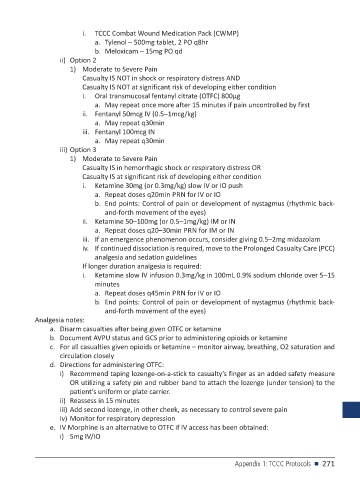Page 273 - PJ MED OPS Handbook 8th Ed
P. 273
i. TCCC Combat Wound Medication Pack (CWMP)
a. Tylenol – 500mg tablet, 2 PO q8hr
b. Meloxicam – 15mg PO qd
ii) Option 2
1) Moderate to Severe Pain
Casualty IS NOT in shock or respiratory distress AND
Casualty IS NOT at significant risk of developing either condition
i. Oral transmucosal fentanyl citrate (OTFC) 800µg
a. May repeat once more after 15 minutes if pain uncontrolled by first
ii. Fentanyl 50mcg IV (0.5–1mcg/kg)
a. May repeat q30min
iii. Fentanyl 100mcg IN
a. May repeat q30min
iii) Option 3
1) Moderate to Severe Pain
Casualty IS in hemorrhagic shock or respiratory distress OR
Casualty IS at significant risk of developing either condition
i. Ketamine 30mg (or 0.3mg/kg) slow IV or IO push
a. Repeat doses q20min PRN for IV or IO
b. End points: Control of pain or development of nystagmus (rhythmic back-
and-forth movement of the eyes)
ii. Ketamine 50–100mg (or 0.5–1mg/kg) IM or IN
a. Repeat doses q20–30min PRN for IM or IN
iii. If an emergence phenomenon occurs, consider giving 0.5–2mg midazolam
iv. If continued dissociation is required, move to the Prolonged Casualty Care (PCC)
analgesia and sedation guidelines
If longer duration analgesia is required:
i. Ketamine slow IV infusion 0.3mg/kg in 100mL 0.9% sodium chloride over 5–15
minutes
a. Repeat doses q45min PRN for IV or IO
b. End points: Control of pain or development of nystagmus (rhythmic back-
and-forth movement of the eyes)
Analgesia notes:
a. Disarm casualties after being given OTFC or ketamine
b. Document AVPU status and GCS prior to administering opioids or ketamine
c. For all casualties given opioids or ketamine – monitor airway, breathing, O2 saturation and
circulation closely
d. Directions for administering OTFC:
i) Recommend taping lozenge-on-a-stick to casualty’s finger as an added safety measure
OR utilizing a safety pin and rubber band to attach the lozenge (under tension) to the
patient’s uniform or plate carrier.
ii) Reassess in 15 minutes
iii) Add second lozenge, in other cheek, as necessary to control severe pain
iv) Monitor for respiratory depression
e. IV Morphine is an alternative to OTFC if IV access has been obtained:
i) 5mg IV/IO
Appendix 1: TCCC Protocols n 271

